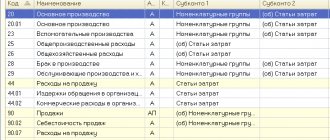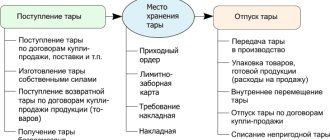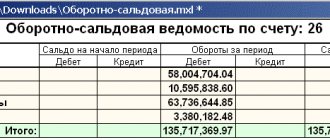Containers are a material asset of an enterprise used for storing, moving and packaging goods. Depending on the purpose and nature of use, containers can be disposable or reusable.
Disposable containers are the packaging we are used to (paper, polyethylene, boxes, bags, etc.). Some categories of goods are placed in it after manufacturing or during the packaging process to preserve their physical and chemical characteristics. In such cases, the packaging remains on the product immediately until it is consumed.
In any trade ]packaging materials[/anchor] are a mandatory expense item, despite the fact that the concept of “packaging” itself is absent in accounting legislation. This is due to the fact that the costs of materials used for packaging are already included in the cost of goods and the buyer does not pay for it separately. Such packaging is positioned in accounting as disposable containers.
As already noted, the costs of preparing goods for sale form their cost (paid by the end consumer). In some cases, reimbursement of costs is borne by the trading organization, and sometimes packaging is not related to trading activities at all.
The packaging process often involves performing a number of complex technological operations using automatic lines, special equipment, materials, etc. In order to simplify tax and accounting, many enterprises consider packaging as an integral element of trade (since when placing a product in consumer packaging, its main characteristics remain the same).
Thus, the purpose of consumer packaging is to ensure the convenience of selling a product to the end consumer. Its price is included in the price of the product.
There are two types of consumer packaging:
- Production - goods are placed in it at a plant, factory, etc. (aerosol cans, cans, tubes, ampoules, etc.);
- Pre-sale, packaging - it is most often used by trading companies selling food products.
How to display packaging costs correctly?
Expenses for disposable packaging can be displayed in accounting in several ways - it all depends on the type of activity of the enterprise.
In production, packaging is part of the material and production assets. To make accounting entries, account 10 “Materials” is used, as well as subaccount 4 “Containers and container materials”.
Subsequent cost accounting is determined by at what stage of production the product is placed in disposable containers:
- Packaging directly during the production process involves writing off expenses for inventories to the debit of account 20 (the amount is included in the cost of goods).
- Packaging of products after production indicates that the amount of costs will be written off to the debit of account 44.
Write-off at average cost
The average cost of inventories is calculated for each type of material as a result of dividing the total cost by quantity. You can determine the average cost using:
- Weighted assessment - the cost is calculated for a specified period, write-off is made only in quantitative form;
- Rolling valuation - determining the cost for each batch of inventory; when writing off, both quantitative and cost indicators are taken into account.
Example
The sewing enterprise Igolka LLC uses two types of fabric to produce one type of product - main and lining. When writing off, the sliding method of calculating the average cost is used:
- 07/01/2016 Igolka LLC received an order to manufacture a batch of this product.
- Remains of the main fabric as of 07/01/2016. — 50m, amount 10,000 rub.; remnants of lining - 50 m, amount 5,000 rubles.
- Work on the order began on July 2, 2016; during the work process, 30 m of base and 25 m of lining are transferred to production daily.
- 07/03/2016 100m of main fabric was purchased for the warehouse for 24,000 rubles.
- 04.07.2016 lining fabric was purchased - 100 m for 11,000 rubles.
Postings for daily write-off of materials into production:
| date | Dt | CT | Operation description | Amount, rub. | A document base |
| 02.07.2016 | 20 | 10 | The cost of the main fabric has been written off (10,000/50*30) | 6 000 | Requirement-invoice, accounting certificate-calculation |
| 20 | 10 | The cost of the lining has been written off (5,000/50*25) | 2 500 | ||
| 03.07.2016 | 20 | 10 | The write-off of the main fabric is reflected (((4,000+24,000)/(20+100))*30) | 7 000 | |
| 20 | 10 | Reflected write-off of lining (5,000/50*25) | 2 500 | ||
| 04.07.2016 | 20 | 10 | Write-off of the cost of the basis (233.33 * 30) | 7 000 | |
| 20 | 10 | Write-off of the cost of the lining (11,000/100*25) | 2 750 |
The average write-off method is the most common, as it is convenient for most enterprises.
Important in packaging accounting!
Depending on what accounting policy the enterprise follows, the costs of packaging material are written off: they can be included in full on a monthly basis in the cost of goods, or evenly distributed between warehouse stocks and goods sold.
To account for packaging at retail enterprises, account 41 “Goods” is used, as well as subaccount 3 “Containers under goods and empty”. The packaging costs are written off by posting to the debit of account 44 “Sales expenses”.
In addition, it is allowed to include packaging costs in the cost price. At the same time, the accounting documentation records the posting of the write-off to the debit of account 90, subaccount 90-2 “Cost of sales”. The actual cost of a product is the totality of all costs aimed at improving its consumer characteristics and not related to direct production. This includes work on packaging, sorting, packing, etc.
However, in reality, when taking into account the costs of containers and packaging, a variety of non-standard situations arise. For example, a company purchased goods or sent a batch of manufactured products for storage. In accounting, these transactions are reflected by postings to accounts 41 “Goods” or 43 “Finished Products”. They indicate the initial cost of the inventory, which cannot be changed in the future. How to keep track of packaging costs in this case?
For such situations, accounting provides account 44 “Sales expenses”. However, before the packaging material is turned into packaging, it must be posted to account 10 “Materials”. Documentary evidence of this operation is the M-11 invoice issued in accordance with the established procedure. It is worth noting that account 44 can also be used to show the costs of packaging goods by third parties. The costs for it are written off through the debit of account 90 “Sales”.
Features of accounting for advertising packaging
When packaging goods, an enterprise can put on the packaging any information about the product itself or about the company, print a logo or details, or publish an announcement about upcoming promotions. In all these cases, costs are recorded and accounted for as advertising. And if the cost of a unit of such packaging exceeds 100 rubles, VAT will have to be charged separately on it.
To print advertising on packaging, a retail enterprise needs:
- Provide documentary evidence of the appropriateness of using this packaging;
- The costs of creating/purchasing this packaging will be recognized as indirect, thereby reducing the base income tax rate.
Procedure for maintaining tax accounting of packaging
Income tax
To determine income tax, expenses associated with placing goods in disposable packaging are recorded according to the same principle as in financial statements. Enterprises specializing in the manufacture of products include these costs in the cost of goods or are classified as trading costs. The majority of trading organizations prefer to take them into account in the form of trade costs, while some still reflect these costs in the cost of goods.
As an illustrative example, consider the following situation:
“Our dry cleaning shop purchases special bags made of thick polyethylene from the supplier. We use them to pack clean items when handing them out to clients. The bags protect products from re-contamination and also improve the quality of service - it is convenient for customers to carry bulky items. However, the tax service considered the use of thick bags to be inappropriate. To pack clean items, experts recommended purchasing less expensive materials (paper, thin bags).”
In many manufacturing plants, packaging is an integral part of the product. In such cases, the costs of it (whether purchasing or manufacturing) are considered direct. Everything else is indirect costs of the reporting period, the correct display of which allows you to reduce income tax.
Packaging, as the final production stage (transformation of a product into a commodity), involves the type of expense that is accepted without question by the tax authorities. Everything is very clear here: packaging makes the product suitable for sale. Claims arise if packaging is not necessary in a particular case or if cheaper solutions can be used.
Tax authorities always carefully check the costs of an enterprise, since the amount of income tax depends on this. They pay close attention to expensive packaging: they determine the feasibility and justification of the costs for it, find out whether it is possible to do without it in a particular case. That is why the costs of purchasing packages given to clients free of charge often fall into the “unreasonable” category.
It should be understood that tax authorities do not have the authority to assess costs for their rationality, validity, and feasibility. However, no one wants to have fruitless arguments. It is much more reliable and safer to ask an opinion on this matter directly from a representative of the Russian Ministry of Finance.
“When determining income tax, all expenses that are related to the activities of the enterprise, are economically justified and documented are recognized as appropriate. For example, if a company can prove that additional packaging is necessary to preserve some characteristics of the product, then tax authorities have no right to doubt the advisability of these expenses. Such expenses are quite capable of reducing income taxes. Documentary evidence means: the manager’s order to introduce additional packaging, invoices or sales receipts into the production or sales cycle.”
Value added tax
The company will not have problems deducting VAT from packaging costs if it is a payer of this tax. In this case, the procedure is carried out in the standard manner.
However, many people at this stage have misunderstandings in packaging accounting. For example, packaging costs are included in the cost of production and are not indicated separately in the reporting documentation. The buyer pays only for the product, but at the same time receives both the product itself and the packaging. It turns out that he gets the latter for free. Free transfer of goods is a sale, which means that VAT should also be charged on the cost of packaging. As for the calculation of income tax, it does not take into account the costs of packaging sold free of charge.
This is a fairly common mistake. If the buyer pays for the goods and receives the goods and packaging, then in 100% of cases the costs of purchasing this packaging are already included in the cost of the goods. It does not go to the consumer free of charge; VAT on it is paid along with the general VAT on the product. Thus, no gratuitous sale occurs and no additional tax deductions need to be made.
To obtain an authoritative opinion on this issue, we decided to contact an employee of the Ministry of Finance of the Russian Federation.
“In tax legislation, VAT for a specific enterprise is considered as the total cost of goods sold/transferred to customers at base market prices before taxes are included in them. The contract price of a product may include various company costs (including packaging costs), for which tax is not calculated. Thus, VAT is not charged separately on the cost of packaging.”
Some features of the sale of the shipped product
The shipment of commercial products is accompanied by a change and transfer of ownership of it. A change of owner takes place in a situation where goods are sold when (Article 223 of the Civil Code of the Russian Federation):
- the product is delivered to the buyer by the seller;
- delivery of valuables to the buyer is carried out by a third-party carrier;
- The transfer of products by the manufacturer is made to the seller directly.
Question: How to reflect in accounting and tax accounting the formation of a reserve for the buyer’s doubtful debt arising in connection with the shipment of products? According to the inventory results at the end of the first quarter, the organization has an unsecured receivable from the buyer in the amount of RUB 1,180,000. (including VAT) with a payment delay of 55 days, which arose in the same quarter. The specified unsecured receivables were recognized as doubtful. The organization has no accounts payable to this buyer. The organization has no other overdue receivables. According to the accounting policy, the accrual method is used for profit tax purposes, the organization forms a reserve for doubtful debts, and the reporting periods are the first quarter, half a year and nine months of the calendar year. View answer
The fact of sale is accompanied by documents (contracts, invoices, acceptance certificates). It is not prohibited by law to use in a contract the moment of changing ownership of the commodity mass upon its receipt or during a certain period, including after making partial payment, immediately at the time of transfer of the product to the buyer’s warehouse. But any condition must necessarily be reflected in the agreement of the parties to the transaction.
Question: How to record settlements with the buyer of products on the terms of 100% prepayment (advance payment), if the products are shipped within five calendar days from the date of receipt of funds? In March, the organization received an advance in the amount of 120,000 rubles, which is 100% of the contract price of the products, for the upcoming shipment of products, the sale of which is subject to VAT at a rate of 20%. Products were shipped in April within five calendar days from the date of receipt of the advance payment. Income and expenses for profit tax purposes are determined using the accrual method. View answer
Payment for the commodity mass is made by the buyer at the time of receipt or within a certain period agreed upon by the parties. After making the payment, the recipient of the product becomes its full owner.
If money for the delivered product is not transferred within the time period previously agreed upon by the parties, the goods must be returned to the seller. If the payment deadline is missed, the seller has the right to demand the return of the product or payment for it.
For your information! Such conditions are indicated in the agreement of the parties, as well as the criteria for changing the copyright holder of the subject of the contract or the right of disposal by the acquirer before the end of the settlement procedure.








